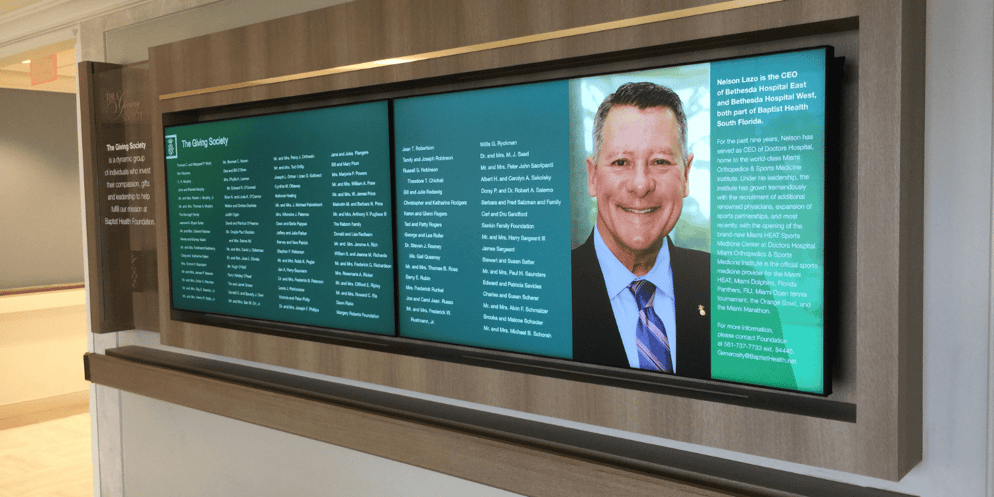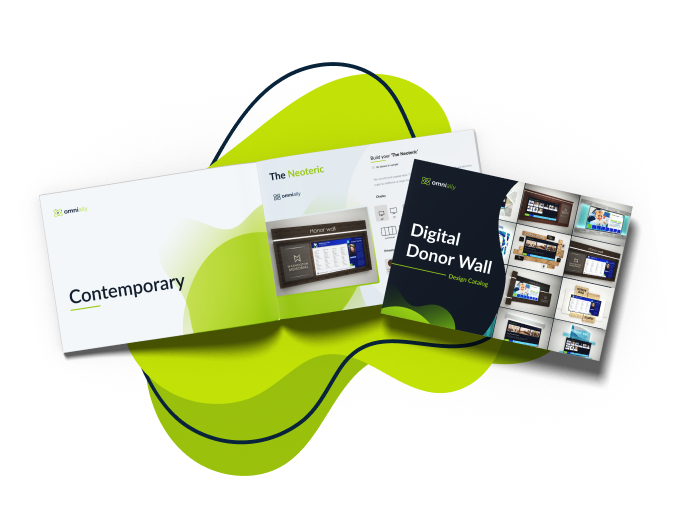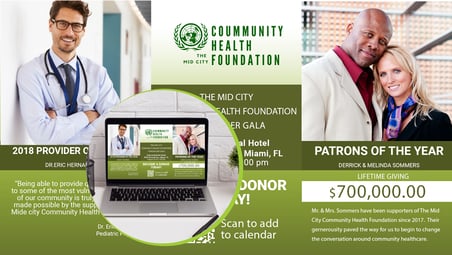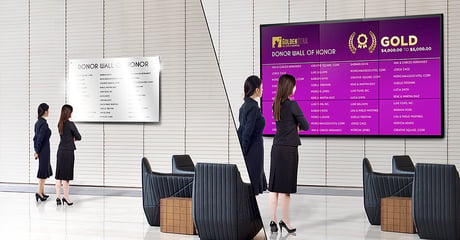- Blog
- >
- The Donor Recognition Handbook: 10+ Top Ideas for Nonprofits
Blog
The Donor Recognition Handbook: 10+ Top Ideas for Nonprofits

There’s no question that donors play a key role for nonprofits—without their support, charitable organizations would struggle to meet their goals and establish the initiatives needed to work towards their missions. It’s extremely important to show donors that their gifts and contributions are appreciated in meaningful ways.
Your nonprofit likely already has donor recognition strategies in place, but it’s always worth looking for tips and practices to spruce up your plan. To help you do that, this handbook will cover the following topics:
- What is Donor Recognition?
- Why Meaningful Donor Recognition Matters
- Key Factors for Donor Recognition
- 5 Donor Recognition Best Practices
- 10+ Top Donor Recognition Ideas
With the right strategies, you’ll successfully convey your gratitude to your most important supporters. They’ll feel good about their meaningful support, leading them to make repeated (even larger!) gifts.
What is Donor Recognition?
Donor recognition refers to a nonprofit or charitable organization's actions to show appreciation for supporters who make gifts to aid its mission. These actions can range from sending a simple thank-you note to inviting them to an exclusive donor event to engraving a donor’s name on a wall display.
Each nonprofit’s recognition strategy should be tailored to its audience’s unique preferences, making no two strategies completely alike. While it’s valuable for you to examine how other nonprofits show their donors appreciation, keep in mind that what works for them might not work for you. Ultimately, you know your donors the best and understand what they would value in terms of appreciation.
Why Meaningful Donor Recognition Matters
Beyond making donors feel good for their contributions to your nonprofits, meaningful donor recognition also:

- Boosts donor retention. When donors feel good about their gifts, they’re more likely to give again. A strong donor recognition strategy will boost donor retention, allowing you to increase average donor lifetime values and reduce donor acquisition costs.
- Encourages continued and greater support. As you strengthen your relationship with your donors, they’ll be more likely to upgrade the gifts they make to your organization. Some individuals may commit to giving regularly through recurring donations, whereas others may make larger gifts, resulting in more funds for your mission.
- Deepens engagement. Showing your appreciation for your donors’ support may inspire them to increase and deepen their engagement with your mission. Aside from making gifts, they may also advocate for your cause on social media, attend fundraising events, and spread the word about your nonprofit to their peers.
- Establishes a positive reputation. Nonprofits are inherently held to a higher standard than their for-profit counterparts. After all, donors give you their hard-earned funds with little personal gain. Having a reputation as a nonprofit that’s grateful for any support it receives will encourage potential supporters to take the leap and make a donation.
- Strengthens community. Ultimately, the goal of a nonprofit is to build a strong community dedicated to furthering its mission. By showing your appreciation, you’ll make donors feel that they’re a crucial part of your community, allowing them to foster connections with individuals who share their interests.
The key here is that recognition must be meaningful. Just like you, as an individual, can tell when someone is being insincere with their gratitude, your nonprofit’s donors will know if the appreciation you show is disingenuous or superficial. In that case, you won’t be able to reap the benefits of donor recognition, and your nonprofit may even suffer for it.
To ensure your recognition activities are meaningful to your supporters, establish a plan that outlines exactly how you’ll show appreciation and deepen relationships with donors.
Key Factors for Donor Recognition
When establishing your donor recognition plan, keep the following factors in mind:

Private or Public
Donor recognition can be:
- Private. Common private recognition activities include thank-you notes, phone calls, and even one-on-one meetings with key nonprofit stakeholders such as beneficiaries or board members. Generally, this approach is more personal and is a great way to show a donor just how special they are.
- Public. Common public recognition activities include shout-outs through social media and email newsletters, installing a public display, or referencing the donor at an end-of-event speech. This approach allows your nonprofit to build a stronger donor community while emphasizing key support given to your mission.
When deciding whether recognition should be public or private, keep your donors’ preferences in mind.
Some of your donors may be private individuals who would prefer to stay out of the limelight. For these supporters, private recognition will be far more meaningful and genuine. Don’t be afraid to occasionally survey your supporters and ask them how they feel about the private or public nature of your appreciation efforts. Be sure to consider their feedback as you mold your donor recognition strategy.
Frequency and Timing
Aside from whether your recognition efforts will be private or public, you also need to consider frequency and timing. Usually, your recognition efforts will be:
- Immediate. It’s a best practice to promptly acknowledge donors after they’ve donated—generally, experts recommend thanking donors within 72 hours of their gift, with an email, letter, or phone call. However, that doesn’t give you much time for a larger show of appreciation, which some donors (particularly major donors) might expect.
- Regular. Regular recognition allows you to emphasize your genuine gratitude for your donors while providing additional touchpoints with them. Activities that fall under this category include frequent updates on the program or initiative the donor specifically supported, invitations to appreciation events, or featuring key donors in your year-end impact report.
The best strategies make use of both immediate and regular recognition. That way, you get the benefits of thanking supporters promptly after their donations and the benefits of staying in contact and properly stewarding them.
Recognition Tiers
Appreciation doesn’t look the same for every action—for example, just think of the difference in how you would feel if one friend got you a greeting card for your birthday and the other baked you a homemade cake. The same idea applies to your nonprofit’s donors.
Ideally, you should break your recognition efforts into distinct tiers, with different activities for different donor categories. Characteristics that inform which category a donor belongs to include:
- Donor type. Is the donor an individual, a business or corporation, a foundation, or another entity?
- Donation type and amount. How much did the donor give—or, in other words, are they a small, mid-size, or major donor? Did they make their gift in cash, in-kind goods or services, or another type of resource?
- Engagement level. How frequently has the donor given to your nonprofit or engaged with its mission? Are they a one-time, recurring, or legacy donor? How else have they interacted with your organization?
Tailor your donor recognition activities to your donor categories to best meet their needs.
For example, one-time donors who have not interacted much with your organization probably don’t need a large show of gratitude off the bat, but you’ll benefit from thanking and casually encouraging them to stay connected with your nonprofit. On the other hand, a longtime major donor will probably expect a grander and more personal gesture of appreciation and frequent status updates on the programs they’ve funded.
5 Donor Recognition Best Practices

1. Keep the Focus on the Donor
When conducting your recognition efforts, keep your focus on the donor by using language that frames your nonprofit’s programs as something the donor has helped you achieve. In particular, emphasize the role that the donor has played.
Let’s take a look at two hypothetical examples of thank-you letters from an ocean conservation nonprofit:
- Thank you for your recent donation to our nonprofit! We wanted to give you more details about our latest cleanup efforts. Over the past month, our team has been working hard on a beach cleanup project, and we’ve made significant progress in reducing the waste on our local beaches. We are confident that these efforts will contribute to a healthier ocean!
- Thank you so much for your generous contribution to our ocean conservation efforts! Your support will help our beach cleanup project, where we aim to remove as much pollution as possible from our community’s beaches. This will help keep our stretch of the ocean clean and healthy. With generous donations such as yours, we’ll protect the ocean’s ecosystem and local marine life!
While both of these notes start with a quick thank-you and then dive more deeply into the nonprofit’s activities, the former keeps its focus on the nonprofit. This can make the donor feel underappreciated or that their gift is relatively insignificant.
On the other hand, the latter note stays focused on the donor. It reframes its activities as projects that the donor’s generosity empowers them to complete, making it a much more effective appreciation message.
2. Highlight the Donor’s Impact
Tie the donor’s gift to a tangible, concrete impact to demonstrate the value of their contribution to your nonprofit and show them that their funds are going toward a good cause. For example, if your nonprofit provides food for families experiencing poverty, you might say something along these lines:
- Your donation of $25 allows us to provide canned food for a family of four for a week.
- The $50 gift you made funds our soup kitchen, where we cook over 5,000 hot meals for families experiencing poverty every Sunday.
- This Thanksgiving, your $75 donation allows us to spread the Thanksgiving spirit by giving two families in need roasted turkeys.
Don’t be afraid to get specific—your donors will appreciate that you’re pushing aside the curtain for them, so to speak, and giving them a glimpse into what exactly their donations can achieve.
3. Personalize Recognition Efforts
No one wants to feel like they’re just a face in the crowd. Go the extra mile to recognize your donors’ individual contributions by personalizing your recognition efforts. In your thank-you efforts, be sure to reference their:
- Name. This includes their first and last name and any other relevant titles.
- Gift amount. Specify the amount they donated. You might even mention their lifetime donation amount if they’ve previously made gifts as well.
- Other involvement. If they’ve volunteered with your organization or participated in peer-to-peer fundraising on your behalf, be sure to mention that too.
By including details like these, you’ll show your donors that you’re aware of them as individuals and recognize all of their support, not just their most recent donation.
4. Invite Further Engagement with Your Mission
In addition to saying thank you to donors for their financial support, invite them to engage with your nonprofit’s mission further through:
- Volunteering
- Attending events
- Advocacy efforts
- Joining your donor communities
After a designated period, you can also ask supporters to make another donation. However, be very mindful of the timing of such a request. If you make your appeal too soon, the donor will feel that you only care about the funds they can contribute. It’s best to make this request a few months after the first donation, after a few stewardship messages listing other ways that the supporter can engage further with your mission.
5. Don’t Be Afraid to Get Creative
Keep an open mind with your donor recognition efforts—don’t limit yourself to what’s traditional or what’s historically worked for nonprofits. Always stay on the lookout for new, innovative ideas that will help you take your recognition strategy to the next level. Even if they don’t work exactly as you intended, they’ll still give you valuable insights into your donors’ preferences, improving your future donor appreciation strategies.
10+ Top Donor Recognition Ideas
At this point, you’re ready to start filling in your donor recognition plan with strategic activities that demonstrate your appreciation, deepen connections with supporters, and inspire future giving. Let’s take a look at the top donor recognition ideas your nonprofit can leverage.
Donor Walls
A donor wall, also known as a donor recognition wall, is a display that features the names of your nonprofit’s donors. They’re typically installed in a highly visible area of the nonprofit’s facilities, so all visitors have an opportunity to view the wall. This is considered a fairly grand gesture of recognition and is usually done in recognition of a nonprofit’s most esteemed and impactful donors.
Donor walls come in one of three forms:

- Traditional. These are physical installations, often taking the form of names and designs etched on a wall or plaques. However, many nonprofits get creative with traditional donor walls, such as by incorporating sculpture, engraved bricks, and more—take a look at the School of the Art Institute of Chicago’s innovative approach, for example.
- Digital. Digital donor walls are physical installations, but they feature large digital screens instead of static materials. You can incorporate visual elements and interactive media to create an engaging viewer experience. Plus, you can always adjust what’s on the screen, making this a great option for nonprofits with flexible donor recognition goals.
- Virtual. Nonprofits with very little wall space or low budgets can still reap the benefits of donor walls by taking them virtual. These typically look like webpages that list the names of key donors, sometimes with a little bio as well.
Donor walls are a tried-and-true way to recognize donors and increase giving, yet they are a flexible option that allows for plenty of creativity—that’s why they’re our top donor recognition idea.
If you’re interested in installing a donor wall, OmniAlly is the top provider of digital walls that are intuitive, modern, and authentic. Our industry-leading digital donor recognition systems are sure to support your appreciation goals in an engaging and personable way. Check out our catalog for design ideas we can bring to life for your organization!
Thank-You Notes
Letters and notes are a classic donor recognition idea. They’re a particularly great option for showing appreciation to donors immediately after they’ve made a gift. Common channels thank-you notes are sent through include:
- Text message
- Direct mail
To make your donors feel even more valued, ask your beneficiaries to handwrite thank-you notes for key supporters. Donors will appreciate hearing from the people whose lives their funds have directly impacted.
eCards
Digital greeting cards, also known as eCards, take thank-you notes to the next level as an appreciation strategy. With an eCard, your nonprofit can show its gratitude in a visually engaging way that donors will love. Plus, this option is much more cost-effective and environmentally friendly than sending physical notes.
To leverage this donor recognition strategy, you’ll partner with an eCard provider. You’ll create eCards branded to your nonprofit, choosing what visuals will appear on them and even adding animations or interactive elements. Then, you’ll set up an automated system that automatically sends eCards to supporters after they donate! Include a short but heartfelt thank-you message and the gift receipt for the donor’s records.
Phone Calls
For some donors, nothing beats the connection of hearing another human voice. These donors will appreciate a thank-you phone call and the opportunity to chat with your nonprofit’s staff members about the impact they’ve made. Set your team members up for success by preparing a script template so they have talking points ready before the conversation starts.
Aside from staff members, you can also have your beneficiaries, volunteers, board members, or even your nonprofit’s director handle calls. Major donors especially will appreciate hearing a thank-you from key figures in your community.
Social Media Highlights
Highlight key donors on your social media pages for a quick yet effective public recognition idea. Create a post featuring the donor’s picture, a description of their contribution and what it helped you achieve, and a short bio of the donor’s history. You can post this across multiple platforms so all your supporters can learn about your most impactful donors. Just be sure to ask the donor’s permission before publicly featuring them!
Appreciation Videos
If your nonprofit’s team members have experience with video creation and editing, appreciation videos are a great way to show donors just how much you appreciate them. Your video can be a general thank-you to all of your donors, or you can create individual, personalized videos for your most generous supporters. Film your beneficiaries, staff members, volunteers, and board members saying a quick thank-you message and put it all together so donors understand the impact of their gifts.
Branded Gifts
As a show of appreciation, some nonprofits will send small gifts to their generous supporters. This donor recognition idea doesn’t need to break the bank—your gifts can be as simple and inexpensive as branded t-shirts, mugs, tumblers, notebooks, and tote bags. Donors will feel recognized for their gifts and they’ll spread awareness of your nonprofit’s brand every time they use the merchandise!
Donor Lunch or Dinner
Invite donors to socialize, network, and connect with your mission through a dedicated donor lunch or dinner. You’ll pay for the experience and your donors will get to have a fun time meeting like-minded individuals. This idea is best suited for nonprofits that have high concentrations of supporters in specific areas. For example, a Chicago-based animal shelter might host a dinner just around the corner from their facilities.
Behind-the-Scene Experiences
Push aside the curtain and let key donors in on the behind-the-scenes action of your nonprofit. Give them a tour of your facilities, offer priority seating at events, or allow them to attend meetings with organizational leaders. This donor recognition idea is best for top-tier donors who have demonstrated a serious commitment to your cause. They’ll appreciate the opportunity to dive into the nitty-gritty details of your operations.
Donor Recognition Event
Instead of organizing an event for fundraising or advocacy, host an event dedicated entirely to recognizing key donors. This option is extremely flexible, as you’re free to customize it depending on which subset of donors you’re showing gratitude toward. It can be as casual or as formal as you like. And, if your supporters are spread out across the country or the globe, you can take your event online or host it in a hybrid format.
Named Programs or Initiatives
If you’ve ever been to a museum or university, you’ve probably noticed that certain wings or buildings are named after specific people. Your nonprofit can use this strategy as well by naming specific projects or buildings after your most important supporters.
Donor of the Month Program
Incorporate regular public recognition with a donor of the month program. For this idea, you’ll pick a specific donor every month to honor. This doesn’t have to be the individual who made the largest gift. It could be a donor who’s engaged with your nonprofit on all fronts, including advocacy and volunteering. Or, it could be a donor who made a special contribution, such as sponsoring a matching challenge. Regardless of what your criteria are, be sure to clearly define it.
Offer the featured donor certain perks to emphasize your gratitude toward them. You might shout them out on social media, send them branded merchandise, and give them an exclusive behind-the-scenes tour to truly make being the donor of the month special.
Giving Societies
To encourage supporters to join certain highly sought-after subsets of donors, some nonprofits establish giving societies. Commonly, societies are established for recurring donors, legacy donors, planned donors, and major donors. Offer donors perks for joining each of these groups, and clearly outline how supporters can be inducted into each society. For example, you might establish that donors who make gifts totaling over $10,000 are eligible to join your major donor society.
Donor Hall of Fame
If you want a way to highlight your nonprofit’s most generous, impactful, and influential donors, look no further than the donor hall of fame. For this idea, you’re essentially taking your donor month of the program to the next level. Every year or every few years, you’ll choose one or two donors to be inducted into the hall of fame. You can celebrate their contributions by:
- Hosting a dinner or event in their honor
- Adding their name to your donor wall
- Naming an initiative or program after them
With this idea, you’ll ensure that your key donors are immortalized for their generosity and contributions, demonstrating your sincere appreciation for their support.
Board Member Invitation
The board of directors is the governing body of the nonprofit. They oversee high-level strategy, ensuring that the organization is on a path to a sustainable future where it can continue to fulfill its mission. This group is made up of individuals who are truly passionate about the nonprofit’s cause, what it stands for, and the community it’s trying to build.
Honor your most devoted donors by inviting them to serve as members of your board. Allow them to take a hands-on role with your organization and make positive changes that support your mission and future growth.
Wrapping Up: Strategic Donor Recognition
A robust donor recognition plan will include several of the ideas listed above, laid out in a way that makes sense for your nonprofit’s unique needs and donor categories.
As you begin your planning, keep in mind that ultimately, recognition should take the form that makes your unique supporters feel the most appreciated. Use that as the foundation for your strategy, and you’ll be off to a great start!

Design Catalog for Digital Donor Walls
Get inspiration from our digital donor wall designs.

About the author: Holley Snaith





